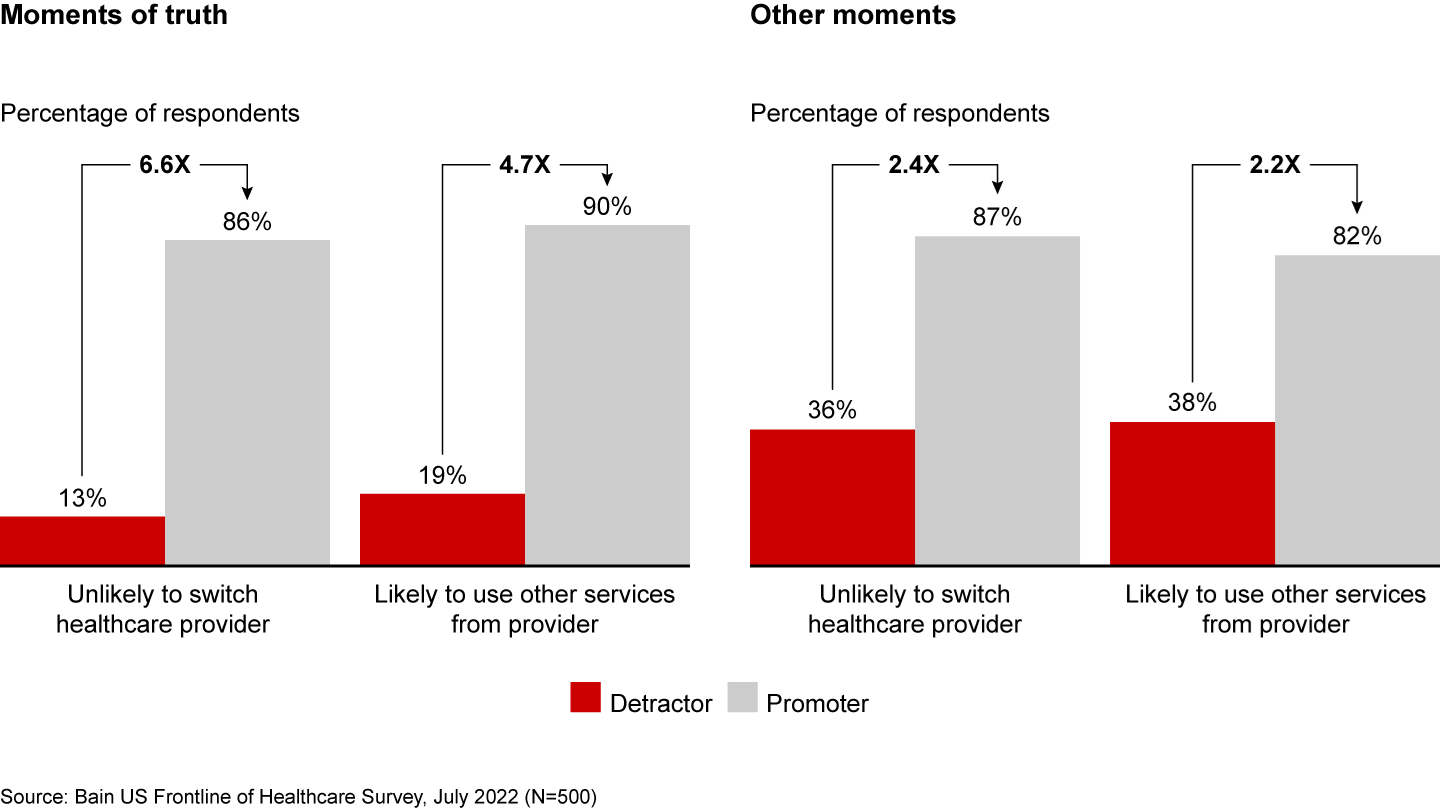Frontline of Healthcare

In evidenza
- A recent Bain survey reveals that 65% of healthcare consumers expect a more convenient experience while 70% expect more responsiveness from providers compared with how they felt three years ago.
- As industry-disrupting companies deliver simpler, more engaging experiences, traditional providers will need to raise the bar for patient interactions across the care and wellness journey.
- Several moves can help providers build an enriching customer experience, including focusing on episodes with the highest potential to delight or disappoint.
Across the US, the patient experience is marred by long wait times, difficulty scheduling appointments, the need to chase down answers, confusion over billing, and more. That doesn’t bode well with today’s consumers, many of whom have become accustomed to companies prioritizing their convenience and experience in other facets of their lives, leading them to have increasingly high expectations for their healthcare providers, too. Indeed, according to Bain’s recent Frontline of Healthcare survey, 65% of healthcare consumers say they expect a more convenient experience, and 70% expect more responsiveness from their providers compared with how they felt three years ago.
The impetus for change is great: A new generation of healthcare disrupters are hearing the call from patients. They’re delivering simpler, more convenient, more engaging experiences—and they’re stealing share from traditional providers across the continuum of care. Consider primary care disrupters Oak Street Health, ChenMed, One Medical, and VillageMD; home health disrupters Vivify and CareBridge; and chronic disease management disrupters Omada and Livongo. The threat is becoming too large to ignore.
For traditional providers, consistently delivering excellent experiences is difficult. They face numerous obstacles, including the involvement of many stakeholders, myriad clinical demands, and historically complex processes and workflows. But providers that don’t transform their patient experience continue to miss out on considerable benefits. Bain research shows that across industries, customer-centric organizations outperform their peers, growing twice as fast and generating median total shareholder returns up to five times the US median. In particular, customer-centric healthcare providers often enjoy better clinical outcomes as a direct result of higher patient satisfaction and adherence, stronger brand differentiation, increased employee engagement and satisfaction, higher revenue growth from repeat customers, and increased share of wallet—not to mention the ability to stave off competitive disrupters.
How can traditional providers raise the bar for patient experiences to be on par with their standards for high-quality clinical care? It requires assessing and addressing patient interactions across the entire care and wellness journey to build an experience that truly enriches patients’ lives—one that provides care where, when, and how customers want it.
Step 1: Map your patients’ journeys. Consider how your customer journey looks today and how it could look in the future. Which aspects of the experience could become competitive differentiators? While the details of the journey are unique to each provider, there are consistent elements across organizations, such as finding and accessing care, paying a bill, or receiving ongoing care support, to name a few. By benchmarking against competitors, providers can identify gaps and opportunities. As they evaluate these opportunities, it’s important to consider evolving healthcare trends, such as digital transformation or alternative sites and channels of care.
Step 2: Identify your moments of truth. To improve the patient experience, providers will need to assess customer satisfaction and pain points for specific episodes across their patients’ journeys. That’s no easy feat. But leading companies will diligently prioritize the episodes that matter most to their customers.
We call the episodes with the highest potential to delight or disappoint “moments of truth.” According to our survey, some of the most critical moments of truth include researching and choosing a provider, receiving ongoing care support, navigating care and referrals, and resolving a bill or answering coverage questions. When these moments go wrong, they often create unhappy detractors who vocally criticize the provider, but when they go right, they generate loyal, enthusiastic promoters who recommend the provider to friends and colleagues. While other moments (such as scheduling an appointment, preparing for an appointment, and paying bills or filing a claim) still count, they don’t carry the same weight with patients.
In fact, when a moment of truth goes well, promoters are nearly seven times less likely than detractors to switch providers; for all other moments, promoters are just 2.4 times less likely to switch (see Figure 1). Similarly, after a positive moment of truth, happy customers are around five times more likely than dissatisfied customers to use additional services from a provider, but they are only twice as likely to become repeat customers following positive episodes that aren’t moments of truth.
Moments of truth significantly affect consumers’ likelihood to stay with a provider and use more services


The reward for moments of truth is high, and so is the risk: These episodes are also less likely to reach a satisfactory conclusion and more likely to take more time than customers expect. Given everything at stake, leading providers will invest in assessing and improving these episodes of the patient journey first.
Step 3: Build a true feedback system that goes beyond metrics. Best-in-class providers put customer feedback at the center of their organizations and demonstrate a consistent leadership commitment to improving the patient experience. Many implement a Net Promoter System℠ that captures the voice of the customer to continuously measure satisfaction and uncover pain points. The closed loop system allows frontline teams to both respond quickly to customer feedback and escalate systemic issues to dedicated customer experience teams, who then address problems more broadly throughout the organization. Actionable insights, rather than just metrics, are at the core of their decision making.
Step 4: Make improvements based on insights. The actions taken to address pain points or expand on delightful experiences don’t have to be huge, transformative changes. In fact, we found that many moments of truth (such as resolving a bill, answering a coverage question, or getting a referral) are tangential to the actual delivery of care. Improving these moments doesn’t require changing clinician behavior or reshaping the clinical operating model—all in all, there is plenty of low-hanging fruit. Organizations can begin by redesigning and prototyping high-priority episodes and then piloting changes to test, learn, and adapt.
As part of this process, it’s crucial that organizations align their digital approach with moments of truth. It’s commonly posited that the future of healthcare is digital. We agree, but all too often, digital isn’t delivering what customers truly need. When providers deploy digital health tools without considering patient needs, they can actually create pain points.
Hence, digital health tool adoption remains low. In fact, even the simplest digital tools have some of the highest churn rates: For instance, electronic medical records and online appointment booking have churn rates of 11% and 13%, respectively, according to our survey results. Patients complain of technical issues, insufficient capabilities, and security and privacy concerns. Leading providers will get ahead of these pain points as they pilot digital solutions.
What’s at stake if providers don’t incorporate patient-centric thinking into their business models? Loss of customer base, increased costs, wasted investments, employee attrition—the list goes on. To keep up in an increasingly competitive environment full of customer-focused disrupters, successful providers will put customer centricity at the heart of every decision they make, matching high-quality care delivery with an equally high-quality patient experience.
The authors would like to thank Monica Pinto Basto and Brittany Rodriguez for their contributions.